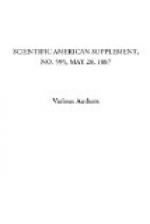Now, when we are working in the laboratory with a steady light, we may be at ease with this method, but when we come to working with light such as the sun, in which there may be constant variation, owing to passing, and may be usually imperceptible, mist, we are met with a difficulty; and in order to avoid this, General Festing and myself substituted another method, which I will now show you. We made the comparison light part of the light we were measuring. Light which enters the collimating lens partly passes through the prisms and is partly reflected from the first surface of the prism; that we utilize, thus giving a second shadow. The reflected rays from P_{1} fall on G, a silver on glass mirror. They are collected by L_{5}, and form a white image of the prism also at F.
The method we can adopt of altering the intensity of the comparison light is by means of rotating sectors, which can be opened or closed at will, and the two shadows thus made equally luminous. [Shown.] But although this is an excellent plan for some purposes, we have found it better to adopt a different method. You will recollect that the brightest part of the spectrum is in the yellow, and that it falls off in brightness on each side, so instead of opening and closing the sectors, they are set at fixed intervals, and the slit is moved in front of the spectrum, just making the shadow cast by the reflected beam too dark or too light, and oscillating between the two till equality is discovered. The scale number is then noted, and the curve constructed as before. It must be remembered that, on each side of the yellow, equality can be established.
This method of securing a comparison light is very much better for sun work than any other, as any variation in the light whose spectrum is to be measured affects the comparison light in the same degree. Thus, suppose I interpose an artificial cloud before the slit of the spectroscope, having adjusted the two shadows, it will be seen that the passage of steam in front of the slit does not alter the relative intensities; but this result must be received with caution. [The lecturer then proceeded to point out the contrast colors that the shadow of the rod illuminated by white light assumed.]




